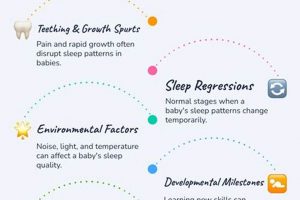Infant vocalizations during sleep, often characterized by soft, plaintive sounds, represent a common phenomenon in early childhood. These sounds, sometimes accompanied by slight movements, can be a source of concern for caregivers. However, such nocturnal expressions are generally a normal part of the sleep cycle.
Understanding the underlying causes of these sleep-related vocalizations offers several benefits. It can alleviate parental anxiety, reduce unnecessary interventions that disrupt a baby’s sleep, and promote a more informed approach to infant care. Historically, these sounds were often misinterpreted as signs of distress, leading to potentially disruptive practices like premature feeding or rocking. A clearer understanding allows for a more responsive and less intrusive approach.
The subsequent sections will explore the various physiological and developmental factors contributing to these nocturnal whimpers. Examination of sleep stages, gastrointestinal influences, neurological development, and environmental considerations will provide a comprehensive overview of the reasons for these infant sounds during sleep.
Understanding Infant Sleep Vocalizations
The following tips offer guidance for understanding and responding to infant sleep vocalizations, aiming to promote both infant well-being and caregiver peace of mind.
Tip 1: Monitor Sleep Patterns: Observe the baby’s sleep cycles. Brief periods of whimpering are often associated with the transition between sleep stages. Track the frequency and duration of these vocalizations to identify any patterns.
Tip 2: Rule Out Physical Discomfort: Ensure the infant is not experiencing physical discomfort. Check diaper wetness, room temperature, and clothing tightness. Address any immediate needs that could be causing distress.
Tip 3: Assess Feeding Schedules: Evaluate feeding schedules. While occasional whimpering may be related to hunger, avoid overfeeding in response to every sound. Consult with a pediatrician regarding appropriate feeding amounts and intervals.
Tip 4: Consider Environmental Factors: Minimize environmental stimuli that could disrupt sleep. Maintain a dark, quiet, and appropriately temperature-controlled sleep environment.
Tip 5: Avoid Immediate Intervention: Resist the urge to immediately pick up or feed the baby at the first sign of whimpering. Allow a short period for self-soothing, unless clear signs of distress are present.
Tip 6: Document Observations: Maintain a sleep diary or log to document the baby’s sleep patterns, including frequency and intensity of sleep vocalizations. This record can be valuable when consulting with healthcare professionals.
These guidelines emphasize observation and a balanced approach. Discern between normal sleep vocalizations and genuine cries for assistance.
The subsequent section will summarize key findings and offer concluding remarks.
1. Sleep Cycle Stages
The sleep architecture of infants differs significantly from that of adults, consisting primarily of two main stages: Active Sleep (analogous to REM sleep) and Quiet Sleep (non-REM sleep). These stages cycle frequently throughout the night. The transition between these stages, particularly from Quiet Sleep to Active Sleep, is often accompanied by brief periods of arousal. During these arousals, the infant may exhibit various behaviors, including whimpering, grunting, or slight body movements. The relative instability of these transitional phases contributes to the likelihood of vocalizations, thus partially explaining nocturnal sounds. Example: A baby might whimper as they shift from deep sleep to a lighter, more active stage where brain activity increases and muscle tone changes.
Active Sleep, characterized by rapid eye movements and increased brain activity, is associated with dreaming and processing information. During this stage, infants may be more responsive to external stimuli, and vocalizations can occur more readily. Quiet Sleep, on the other hand, is a deeper, more restful state. However, even within Quiet Sleep, brief periods of arousal are common as the brain regulates various physiological processes. These arousals are often subtle and may not always result in overt awakenings, but they can manifest as whimpering or other soft sounds. Understanding these stage-specific characteristics allows caregivers to differentiate between benign sounds and potential signs of distress.
In summary, sleep stage transitions and the characteristics of Active and Quiet Sleep contribute significantly to infant sleep vocalizations. Identifying these transitions is crucial for determining if these sounds are a normal part of the sleep cycle or if further investigation is warranted. Recognizing patterns related to these stages can reduce parental anxiety and promote a more informed approach to infant care. This understanding is a key component in the broader context of deciphering the causes and significance of infant sleep vocalizations.
2. Neurological Immaturity
The underdeveloped state of an infant’s nervous system plays a pivotal role in the frequency and characteristics of sleep vocalizations. Neurological immaturity impacts the regulation of sleep cycles, the processing of sensory information, and the coordination of motor activity, all of which contribute to episodes of whimpering during sleep. These processes develop rapidly during the first year of life, leading to changes in sleep patterns and a gradual reduction in such sounds.
- Immature Sleep Regulation
Infants lack the fully developed neural pathways necessary for stable and consolidated sleep. The sleep cycle is shorter and less predictable than in adults, with more frequent transitions between sleep stages. This instability leads to increased arousals and periods of light sleep, during which whimpering is more likely to occur. For instance, a sudden change in environmental noise might trigger a brief arousal and a soft whimper before the infant returns to sleep.
- Limited Sensory Processing
An infant’s brain has limited capacity to filter out sensory stimuli. Mild discomfort, such as a slightly damp diaper or a minor change in room temperature, can trigger a neurological response that manifests as a whimper. Unlike older children or adults who might adjust or ignore these minor disturbances, an infant’s immature nervous system may react more sensitively, resulting in a vocalization.
- Uncoordinated Motor Activity
The neural pathways controlling motor function are not fully myelinated at birth, leading to uncoordinated and involuntary movements. These movements can sometimes disrupt sleep and trigger brief arousals. A sudden twitch or startle reflex might be accompanied by a whimper as the infant briefly awakens and then resettles. The lack of smooth motor control contributes to the instability of the sleep state and increases the likelihood of associated sounds.
- Developing Autonomic Control
The autonomic nervous system, which regulates involuntary functions such as heart rate and breathing, is still maturing in infants. Fluctuations in these physiological processes can influence sleep stability. For example, a slight increase in heart rate during a light sleep stage might trigger a whimper as the infant’s body adjusts. This immature autonomic control can lead to more frequent arousals and associated vocalizations.
In conclusion, neurological immaturity affects sleep patterns. Factors such as unregulated sleep, limited sensory input, uncoordinated movements, and autonomic instability create an environment where sleep is often interrupted by whimpering. These are normal stages of development, and their characteristics can help parents to better understand behavior.
3. Gastrointestinal Activity
Gastrointestinal activity significantly impacts infant comfort and sleep patterns. The immature digestive system of infants is prone to gas accumulation, colic, and reflux, all of which can disrupt sleep and manifest as whimpering. These physiological processes can cause abdominal discomfort, leading to restlessness and vocalizations during sleep. For example, trapped gas in the intestines can cause intermittent pain, prompting a baby to whimper and squirm while sleeping. Similarly, episodes of gastroesophageal reflux, where stomach contents flow back into the esophagus, can cause burning sensations and discomfort, leading to disturbed sleep and vocalizations. These activities affect rest quality.
The timing of feedings and the composition of the infant’s diet play crucial roles in mitigating gastrointestinal distress. Overfeeding can exacerbate gas and reflux, while certain foods in the mother’s diet (if breastfeeding) or in the infant’s formula can trigger sensitivities. For instance, a breastfeeding mother’s consumption of dairy products may cause gas and discomfort in the infant. Similarly, some infants may be sensitive to certain proteins in formula, leading to digestive upset and disrupted sleep. Careful monitoring of feeding practices and dietary adjustments, in consultation with a pediatrician, can often alleviate these issues. Addressing feeding issues improves comfort.
Understanding the connection between gastrointestinal activity and sleep quality is essential for providing optimal infant care. Recognizing the signs of gastrointestinal distress and implementing appropriate strategies to manage these issues can significantly reduce sleep disturbances and improve infant well-being. Although challenging, identifying and addressing gastrointestinal factors contributing to discomfort can lead to more peaceful sleep patterns and a reduction in associated vocalizations, underscoring its importance. These sounds must be considered.
4. Environmental Sensitivities
Infants possess heightened sensitivity to their surroundings, and environmental factors exert a significant influence on sleep quality and behavior, directly contributing to episodes of nocturnal whimpering. These sensitivities encompass a range of stimuli, including temperature, noise, light, and allergens, each capable of disrupting sleep and prompting vocalizations.
- Temperature Fluctuations
Infants have limited capacity to regulate their body temperature, rendering them vulnerable to both overheating and chilling. Extremes in room temperature can disrupt sleep and cause discomfort, often manifested as whimpering. For example, an overly warm room may lead to restlessness and vocalizations as the infant attempts to regulate body temperature, while a cold environment can induce similar responses due to shivering and discomfort.
- Auditory Stimuli
Loud or sudden noises can easily startle infants and disrupt their sleep cycles. Even relatively quiet sounds may be perceived as intrusive, triggering a brief arousal and subsequent whimpering. For instance, a passing vehicle, a barking dog, or even the creaking of floorboards can disturb an infant’s sleep and lead to vocalizations. The intensity and frequency of these noises directly impact the likelihood of sleep disruption.
- Light Exposure
Exposure to light, particularly blue light emitted from electronic devices, can interfere with melatonin production and disrupt sleep patterns. Even dim light sources, such as nightlights, can influence sleep quality in sensitive infants. Bright light exposure during sleep may inhibit the transition into deeper sleep stages, leading to more frequent arousals and associated vocalizations.
- Allergens and Irritants
Exposure to allergens, such as dust mites, pet dander, or pollen, can trigger allergic reactions that disrupt sleep. Nasal congestion, coughing, and skin irritation can cause discomfort and lead to restless sleep and whimpering. Similarly, irritants such as strong odors from cleaning products or air fresheners can irritate the respiratory system and interfere with sleep quality.
In summary, diverse sensitivity influences can trigger crying during sleep. Temperature changes, noises, lights, and air quality are all factors. Recognizing these environmental elements is helpful.
5. Developing Communication
Infant vocalizations during sleep, though seemingly random, can represent early stages of communication development. While not always intentional or consciously communicative, these sounds may reflect internal states and emerging expressive capabilities.
- Pre-linguistic Expression
Before developing the capacity for language, infants express needs and sensations through a range of pre-linguistic behaviors, including crying, cooing, and whimpering. While crying typically indicates distress, softer sounds like whimpers can represent a broader spectrum of internal states, such as mild discomfort, fatigue, or simply the release of pent-up energy. For example, a baby might whimper softly during sleep after a stimulating day, reflecting the processing of sensory information. These sounds are not yet fully formed communication, but precursors to it.
- Reflexive Vocalization
Many infant vocalizations, including those occurring during sleep, originate as reflexive responses to internal stimuli. These reflexive sounds may be triggered by physiological processes like digestion, changes in body temperature, or minor discomfort. While not consciously communicative, these vocalizations can inadvertently signal an infant’s state to caregivers. A whimper in response to gas, for example, is primarily a reflexive reaction to physical discomfort, but it can also prompt a caregiver to provide relief.
- Emotional Development
Infant vocalizations are closely linked to the development of emotional expression. As infants develop emotional awareness, their vocalizations become more nuanced and varied. Whimpering can serve as a low-intensity expression of negative emotions like sadness or frustration, even during sleep. For example, a baby might whimper while dreaming about separation from a caregiver, reflecting underlying feelings of anxiety or attachment. These vocalizations provide insight into the developing emotional landscape of the infant.
- Learning Through Response
Caregiver responses to infant vocalizations, even during sleep, play a role in shaping communication patterns. When caregivers consistently respond to an infant’s whimpers with comfort and care, the infant may begin to associate these sounds with positive outcomes. This association can, over time, influence the infant’s use of vocalizations as a means of seeking attention and support. A caregiver who gently soothes a whimpering baby reinforces the baby’s understanding that vocalizations can elicit a comforting response.
Thus, the whimper is an early form of expression with various factors. It is pre-speech and not a conversation. These sounds demonstrate the infant’s emotions or signals for those caring for them.
6. Transient Arousals
Transient arousals, brief periods of wakefulness occurring during sleep, represent a primary factor in infant sleep vocalizations. These arousals, often lasting only seconds or minutes, disrupt the continuity of sleep and provide opportunities for the expression of physical discomfort, hunger, or emotional needs through whimpering. The frequency and intensity of these arousals directly correlate with the likelihood of vocalizations. For instance, an infant experiencing a surge of gas pain may enter a transient arousal, prompting a whimper before returning to deeper sleep. These short periods of wakefulness are natural but influence the occurrence of nocturnal whimpering.
The architecture of infant sleep, characterized by shorter sleep cycles and a greater proportion of active sleep, predisposes infants to more frequent transient arousals than adults. Active sleep, associated with increased brain activity and physiological variability, is punctuated by brief awakenings as the infant transitions between sleep stages. These transitions provide a window for external or internal stimuli to trigger arousals and subsequent vocalizations. Furthermore, environmental factors, such as temperature fluctuations or ambient noise, can exacerbate the frequency of transient arousals, thus increasing the propensity for whimpering. Consistent white noise, however, can sometimes lessen it.
Understanding the role of transient arousals is crucial for caregivers to differentiate between normal sleep behavior and potential signs of distress. While occasional whimpering during these arousals is typically benign, persistent or intense vocalizations may indicate underlying issues that require attention. Caregivers can reduce unnecessary interventions by recognizing transient arousals as part of normal sleep. This proactive approach supports a better understanding of infant behavior. In essence, transient arousals provide a key to interpreting seemingly random infant sounds in sleep.
Frequently Asked Questions
The following addresses common inquiries regarding infant sounds while sleeping, offering clarity on typical behaviors and potential concerns.
Question 1: Are such sounds always indicative of distress?
No, these are not consistently indicative of distress. They may be associated with normal sleep transitions, gastrointestinal activity, or sensory processing. Careful observation is necessary to differentiate between typical vocalizations and signs of discomfort.
Question 2: How frequently should these sounds occur to be considered within the normal range?
Occasional sounds are generally considered normal. However, persistent or excessive vocalizations, particularly those accompanied by other signs of distress, warrant evaluation by a healthcare professional.
Question 3: What environmental factors can exacerbate these vocalizations?
Environmental factors such as temperature extremes, loud noises, and exposure to allergens can disrupt sleep and increase the likelihood of whimpering. Maintaining a consistent and comfortable sleep environment is crucial.
Question 4: Is there a correlation between feeding practices and the frequency of these vocalizations?
Yes, feeding practices can influence the frequency of these sounds. Overfeeding or sensitivities to certain foods can contribute to gastrointestinal distress, leading to increased vocalizations. Consulting with a pediatrician regarding appropriate feeding strategies is advisable.
Question 5: When should a healthcare professional be consulted regarding infant sleep vocalizations?
A healthcare professional should be consulted if the sounds are accompanied by difficulty breathing, feeding problems, persistent crying, or other concerning symptoms. Prompt evaluation can help identify and address any underlying medical issues.
Question 6: Do specific sleep positions correlate with increased vocalizations?
While sleep position alone may not directly cause increased vocalizations, supine (back) sleeping is the recommended position to reduce the risk of sudden infant death syndrome (SIDS). Any concerns about sleep position and vocalizations should be discussed with a healthcare provider.
Understanding normal sleeping vocalizations and recognizing potential warning signs is crucial for effective infant care. Observation is essential to note irregularities.
The subsequent section will summarize key findings and offer concluding remarks regarding why do babies whimper in their sleep.
Conclusion
This exploration of “why do babies whimper in their sleep” reveals a complex interplay of physiological and developmental factors. Sleep stage transitions, neurological immaturity, gastrointestinal activity, environmental sensitivities, developing communication skills, and transient arousals all contribute to these common infant sounds. Understanding these multifaceted influences enables caregivers to differentiate normal sleep behaviors from potential indicators of distress. Consideration of these elements promotes informed decision-making and reduces unnecessary interventions.
Continued research into the intricacies of infant sleep is essential for refining our understanding and improving care practices. A comprehensive approach, encompassing observation, environmental adjustments, and collaboration with healthcare professionals, remains paramount in supporting infant well-being and fostering healthy sleep patterns. This vigilance ensures prompt identification and management of underlying issues, contributing to improved infant health and parental peace of mind.







